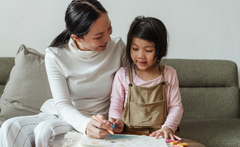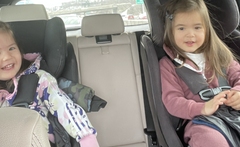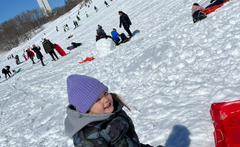
At 9 months, your baby is becoming more and more mobile, giving him a greater sense of control and independence. But at this age, your baby also has no sense of danger and a limited memory for any of your warnings, too.
Your baby will also be extremely expressive with her wants and needs. He may babble and point to ask for help, but be mindful of when you should assist your baby and when you should let him attempt to solve his own problems. Sometimes, it might just be easier to help him with everything, but this could deprive him of a chance to learn valuable new skills.
The more opportunities you can give your baby to discover, test, and strengthen new skills, the more confident and adventurous he’ll be.
Keep in Mind
Keep in mind that the actual age when a typically developing child reaches a milestone really can vary. Each child develops in their own unique way, so there's no need to worry unnecessarily if your child isn't hitting a milestone right away, especially if your child is hitting most milestones in other domains.
That being said, you are your child's best advocate. If there is an issue, it's always best to act early, so if you have any concerns about your child's development, please speak with your pediatrician.
Social and Emotional Milestones
At this age, your baby might seem like she has multiple personalities. Sometimes she’s affectionate and outgoing, other times, she might be anxious, clingy, and easily frightened by unfamiliar people or objects.
If someone tells you that your baby is fearful or shy because you’re “spoiling” her, that’s not true at all. Her various behaviour patterns aren’t caused by you or your parenting style, they happen because she’s now able to tell the difference between familiar and unfamiliar situations. If anything, this is evidence that she has a healthy relationship with you. Anxiety around strangers is actually one of the first major emotional milestones your baby will reach!

At about the same time, she’ll become more clingy and won’t want to leave your side. As she learns about object permanence, she’ll realize that there’s only one of you. When she doesn’t see you, she’ll realize that you’re somewhere, but not with her, and this will cause her distress. She doesn’t have a good sense of time yet so she has no idea when, or if, you’ll be coming back.
Separation anxiety usually peaks between ten and eighteen months and then fades during the last half of the second year. This period can also be emotionally distressing for you, but just know that this is completely normal. In the meantime, try to downplay your leave-taking as much as possible. For example, when you leave, whoever is staying with her can create a distraction as you quickly say goodbye and slip away.
Many babies at this age:
- Are shy or anxious with strangers
- Cry when mom or dad leaves
- Test parental responses to their behaviour
- Show preference for certain people and toys
Language & Communication Milestones
Before he can say many, if any, words, your baby will understand way more than you think. When you mention a favourite toy across the room, he might respond by turning towards it. To help increase his comprehension, keep talking to him as much as possible. Using simple and specific language, narrate the happenings around him, especially during routine activities like bathing, changing, and eating.
Whether you’re reading or talking to your baby, provide him with lots of opportunities to participate. Ask questions and wait for a response or let him take the lead. If he says “baa-gaa-gaa,” repeat it back and see what he does. These exchanges might seem meaningless, but they tell your baby that communication is a two-way interaction and that he’s a welcome participant.
By 9 months, most babies can point to things that they're interested in — and while that may not seem like a big deal, it definitely is. By pointing, your baby is saying, “Hey! I see something and I want you to see it too!” Experts call this “shared attention” or "joint attention," and it's another major developmental milestone.
 This little 9-month-old is pointing at the cute donut print on Jenny & Andy's Organic Crinkle Toy.
This little 9-month-old is pointing at the cute donut print on Jenny & Andy's Organic Crinkle Toy.
If you speak a second language at home, there shouldn’t be any concern that your baby is going to be confused by hearing both languages. Research shows that when children are exposed to two languages at a young age, they’re able to learn both at the same time. The younger he is introduced to both languages, the more proficiently he’ll learn them.
Many babies at this age:
- Understand “no”
- Copy sounds and gestures of others
- Use a finger to point
- Use an increased variety of sounds and syllable combinations in babbling
- Look at familiar objects and people when named
- Participate in two-way communication
Cognitive Milestones
Your baby is curious about everything, but she’ll also have a very short attention span and will move quickly from one activity to another. She may spend about 2-3 minutes, at most, playing with a single toy before moving on to something new.
Her continued observations at this time will help her better understand object permanence - the concept that objects still exist even when you can’t see it. By now, if your baby watches you hide a toy under a scarf, she’ll pick up the scarf and look for the object underneath. If she doesn’t see you hide the toy, she might be puzzled, but by 10 months she’ll be certain that the toy still exists and will continue looking for it.

As mentioned earlier, your baby will begin to develop an important skill called joint attention.
Joint attention involves sharing a common point of reference, such as other people or objects, with someone else. It requires the ability to gain, maintain, and shift attention and plays a role in the development of theory of mind, an important social-cognitive skill involving the ability to think about the mental states of others and to recognize that those mental states may differ from our own.
Many babies at this age:
- Begin to develop joint attention skills
- Watch the path of something as it falls
- Find hidden objects easily after seeing you hide them
- Play peek-a-boo
Movement Milestones

Your baby will likely be sitting without support and be able to catch himself if he topples over. He'll also be extremely mobile and will be in constant motion. He can turn over on his own and flip over suddenly, so using the floor to change diapers instead of the changing table could be a good idea. And, of course, never leave him alone unattended.
By now he’ll likely have mastered, or almost mastered, the ability to crawl. However, a few children never do crawl and, instead, will use alternative movement methods, like scooting on their bottoms or slithering on their stomachs. As long as your baby is learning to coordinate each side of his body and is using each arm and leg equally, there’s no cause for concern. The important thing is strengthening his body to prepare for walking.
Many babies at this age:
- Crawl
- Pull to stand and stand while holding on
- Stand momentarily without support
- Show more control while rolling and sitting
- Pick up small objects using thumb and fingers
- Lets objects go voluntarily
- Put objects in container and take them out
Sensory Milestones

Now, your baby probably still takes two regular naps, one mid-morning and another mid-afternoon. He’ll be sleeping as much as ten to twelve hours at night without needing a middle-of-the-night feeding. But as his separation anxiety intensifies, he may start to resist going to bed and may wake up often looking for you.
You may want to experiment with different strategies to help your baby sleep. For example, you can try leaving the door open so he can hear you or use a favourite toy to keep him comforted in your absence. But it’s important to not do anything that will reinforce, o reward, your baby for calling you in the middle of the night. Go to his side to make sure he’s all right and tell him you’re close by if he really needs you, but try not to turn on the light, rock him, walk with him, or take him to your bed.
With babbling soon to turn into speech, auditory development is significant. Your baby begins to connect sounds to actions, such as the door slamming, or a barking dog. With his finely tuned auditory skills, your baby can now make a distinction between different rhythms, volumes, tones and inflections.
Many babies at this age:
- Focus on objects near and far
- Enjoy a greater variety of smells and tastes
- Investigate shapes, sizes, and textures of toys and surroundings
- Begin to make a connection between object and sounds
Want a handy milestones checklist all in one place?
Download our Comprehensive Developmental Milestones Checklist PDF for free ☑️!
Developmental Milestones By Age
Sources:
- American Academy of Pediatrics. Caring for Your Baby and Young Child, 7th Edition: Birth to Age 5, Fifth Edition. 2009
-
Mundy, P., Newell, L. Attention, Joint Attention, and Social Cognition. Curr Dir Psychol Sci. 1 Oct. 2007; 16(5): 269–274. doi: 10.1111/j.1467-8721.2007.00518.x
- Thomson, Brittany M. Theory of Mind: Understanding Others in a Social World. Socioemotional Success, Psychology Today, 3 Jul. 2017.



